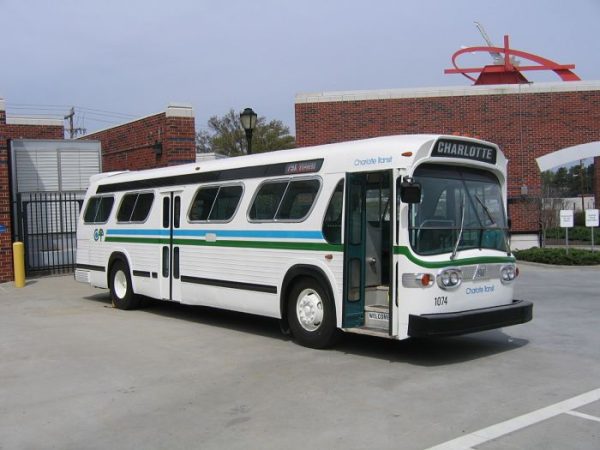Bringing back the bus

Charlotte’s historic and well-loved streetcar No. 85 may have left town for a sojourn at the N.C. Transportation Museum, but another relic of public transportation history may be about to get a shot at local renown.
The Charlotte-Mecklenburg Historic Landmarks Commission is restoring a 1972-vintage bus in hopes it can somehow be put to use by local groups.
In some ways the project to restore Bus 1074 mimics the commission’s work restoring car 85. The electrified trolley cars ceased daily operations 78 years ago, when the city switched to buses. The streetcars disappeared; some were sold, some were scrapped, but none was preserved for posterity. After a lengthy search, car 85 was discovered in 1987 being used as makeshift housing in a then-rural area of Huntersville. The landmarks commission bought and restored it, and the car ran briefly along the tracks now used for Charlotte’s Lynx Blue Line light rail. In March the streetcar was moved to the N.C. Transportation Museum in Spencer.
But Dan Morrill, landmarks commission director, wants to make sure other relics of Charlotte transportation history are properly preserved. Charlotte Area Transit System (CATS) donated Bus 1074 to the commission in early 1992. The first gasoline-powered buses, which arrived in 1934, and the first diesel-powered buses, which arrived shortly after World War II, are not operational and can only be found in museums. Morrill hopes bus 1074, one of General Motors’ first generation of “New Look” buses, will be a functioning tribute to Charlotte transportation history.
GM’s “New Look” buses were created in 1959 and introduced in Charlotte in 1972. They were considered a major design breakthrough, featuring several modern enhancements. They were the first Charlotte buses to be air-conditioned. They were streamlined and considerably lighter than previous versions, and had an easily accessible engine that let mechanics service them and get them back on the road quickly. In stark contrast to the small windows of the “Old Look” buses, they had large windows, earning the buses the nickname the “fishbowl.” Bus 1074 is one of the last surviving Charlotte GM “New Look” buses, which Charlotte retired from service in 1992.
Shortly after being acquired by the landmarks commission, Bus 1074 began the restoration process. The bus underwent considerable cosmetic restoration and is now at Clarke Power Services in Charlotte undergoing several mechanical upgrades. After it receives its new motor, transmission, radiator and other smaller upgrades, the bus will be driven to Mooresville, where a new air-conditioning unit will be installed. Bus 1074 will then be fully restored and operational, ready for its second life.
Morrill and others are discussing the best use for the restored bus. Morrill’s ideas include using it for historic tours and as a mobile classroom for Charlotte residents to learn about local transportation history. Emily Makas, associate professor of urban and architectural history at UNC Charlotte, recently asked students for ideas on how the bus might be used as a “mobile museum.” Makas’ students came up with several ideas based on existing projects such as the American Museum of Natural History’s Moveable Museum and the Bronx Children’s Museum’s “Museum on the Go” bus. Aaron Shapiro, associate professor of history at UNC Charlotte and director of UNCC’s public history program, also asked his students for ideas, and their suggestions included using the bus as a museum to discuss both the history and future of public transportation in Charlotte.
To date nothing has been decided on how to use Bus 1074. Readers with suggestions, or who would like to follow the restoration process may visit them www.landmarkscommission.org.
Jeremy Christ is a graduate student in the Gerald G. Fox Master of Public Administration program and works as a graduate assistant at the UNC Charlotte Urban Institute.
SEE VIDEO FROM LANDMARKS COMMISSION ABOUT BUS 1074
News About Charlotte New Look GM Bus from Dan Morrill on Vimeo.
Jeremy Christ